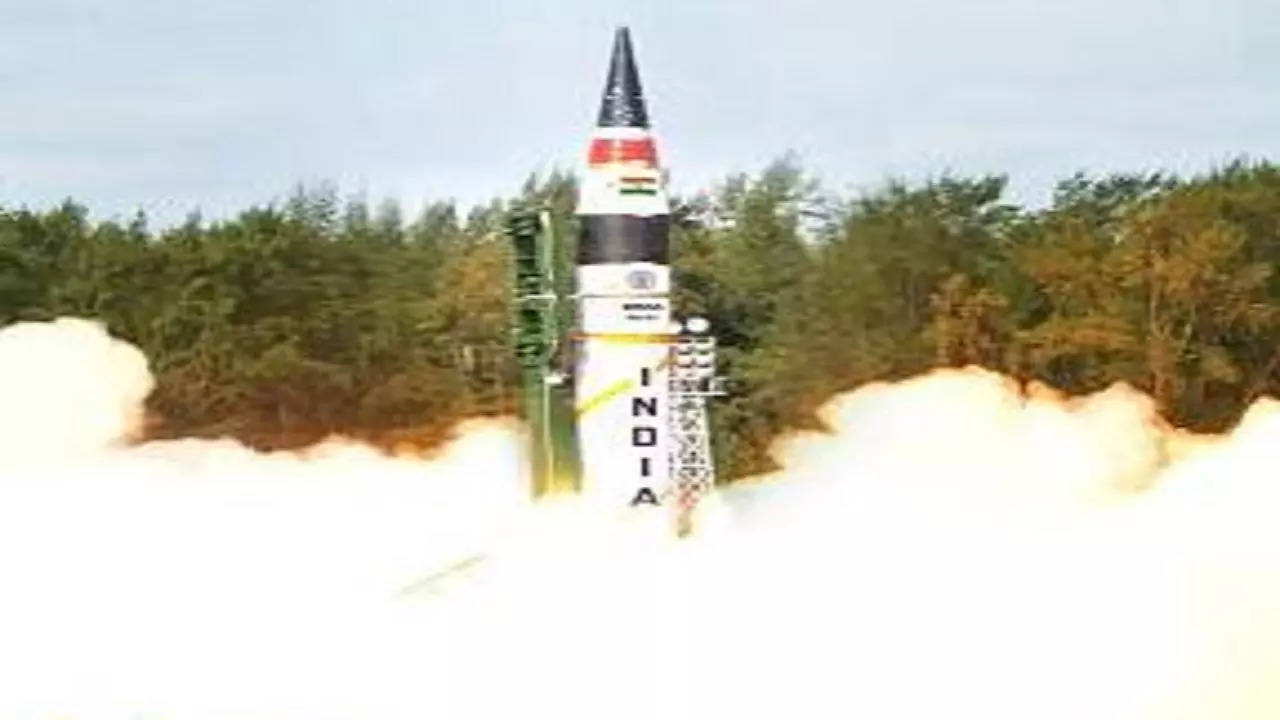Agni-I to Agni VI: Know which are the 7 Agni series missiles that form India's frontline of defence
The Agni missile is a family of medium to long-range ballistic missiles developed by India, developed and operationalised by a team led by former Indian President, Missile-Man Dr APJ Abdul Kalam. Agni missiles are long-range, surface-to-surface ballistic missiles that can carry nuclear bombs. Here are the seven missiles in the series:

Agni-V (Image Courtesy: DRDO)
Photo : Times Now Digital
New Delhi: According to defence establishment sources, India successfully conducted night trials of the Agni-V nuclear-capable ballistic missile on Thursday. The missile is capable of reaching targets beyond a range of 5000 kilometres and is critical to India's self-defence capabilities.
Amid the Chinese tensions along the Arunachal Pradesh border, the test of the inter-continental ballistic missile is being seen as a significant development.
The Agni missile is a family of medium to long-range ballistic missiles developed by India, developed and operationalised by a team led by former Indian President, Missile-Man Dr APJ Abdul Kalam. Agni missiles are long-range, surface-to-surface ballistic missiles that can carry nuclear bombs.
Here are the seven missiles in the series:
1. Agni-I
First in the series of the Agni missile family, was first tested at Chandipur test range in 1989. The Indian Army's Strategic Force Command (SFC) use Agni-I. Agni-I can go 1200 kilometres with a customised weapons load.
2. Agni-II
Agni-II has a range of 2,000-2,500 kilometres, is 20 metres long, one metre in diameter, and weighs approximately 18 tonnes. They are said to be a component of "credible deterrence" against China and Pakistan. In 2019, India successfully performed the first night test of the nuclear-capable intermediate-range ballistic missile Agni-II.
3. Agni-III
Agni-III was first successfully tested in 2007. It certified the missile's operational readiness while increasing India's nuclear deterrent's reach (3,500 km) to the most high-value targets of the country's most likely adversaries (China and Pakistan). Agni-III is also expected to be the world's most accurate strategic ballistic missile of its range class.
4. Agni-IV
Agni-IV was initially tested for its entire 4,000 km range on 15 November 2011 and 19 September 2012 from Wheeler Island off the coast of the eastern state of Orissa. Agni-IV is a bridge between Agni II and Agni III. It can accommodate a one-tonne warhead. It is intended to improve kill efficiency as well as range performance. Agni IV is outfitted with cutting-edge technology, such as an indigenously built ring laser gyro and composite rocket motor. It can even be launched using a road mobile launcher.
5. Agni-V
Agni-V, the missile making the buzz these days is the first of its kind inter-continental ballistic missile (ICBM) of India. It will considerably extend India's reach, allowing it to hit targets more than 5,500 kilometres away. Agni-V was successfully tested for the first time in 2012. The canisterized variant was successfully tested in January 2015. With the latest test, the missile is now lighter than ever before and even brings northern parts of China in the range and makes it night-capable.
6. Agni-P
It is the sixth ballistic missile in the Agni series. Agni-Prime is a next-generation enhanced derivative of the Agni Missile Class. It is a two-stage canisterised missile with a range capability between 1000 and 2000 kilometres. It is India's first 'declared' MIRV (Multiple Independently-targetable Reentry Vehicles) missile, and it is 50% lighter than Agni-III. Agni-Prime may be launched from train and road and stored for an extended period of time. It can be used to target enemy ships in the Indian Ocean.
6. Agni-VI
Agni-VI is an intercontinental ballistic missile in the early phases of development in India, according to the Defence Research and Development Organization. It will be the most recent and advanced iteration of the Agni missile program. It will be able to launch from both submarines and land, and will have a strike range of 8,000-10,000 kilometres with MIRVed warheads.
Trending:
End of Article
Subscribe to our daily Newsletter!
Related News





Delhi Schools Bomb Threat: Centre Calls For Monitoring Of Emails, Need For CCTV Cameras | Details

PM Modi Exposes Congress' 'Double Standards': 'Put Their Manifesto And Speeches On Canvas' | Times Now Exclusive

PM Modi On Two Key Vows His Late Mother Heeraben Made Him Take | Times Now Exclusive

'All 50, Not Just 49...': PM Modi Sets Record Straight On Anti-Muslim Allegations | Times Now Exclusive

Houses Damaged, Over 400 People Affected As Severe Storm Hits Meghalaya's Khasi and Jaintia Hills









